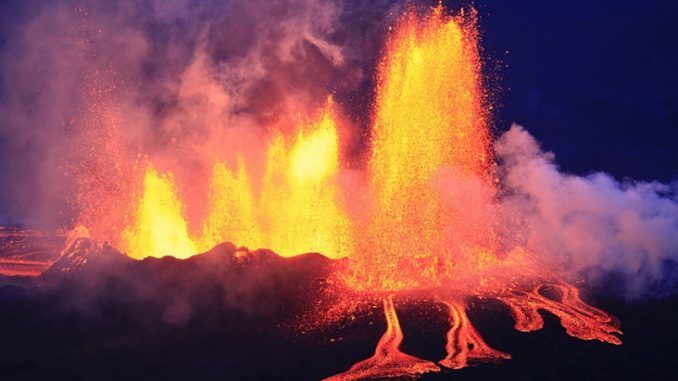
A geophysicist at the University of Iceland has warned that the country’s biggest volcano is ‘clearly preparing to erupt’ after being rocked by a series of earthquakes over recent days.
Bardarbunga, which stands 2,009 metres (6,591 ft) above sea level, is one of a number of volcanoes that geologists are carefully monitoring after a spate of recent earthquake activity, which indicate that the pressure in the volcano is increasing.
According to Páll Einarsson “The reason for the earthquakes in this place is that the volcano Bárðarbunga is inflating, i.e. the pressure of magma in the magma chamber is increasing”

BYPASS THE CENSORS
Sign up to get unfiltered news delivered straight to your inbox.
You can unsubscribe any time. By subscribing you agree to our Terms of Use
Dr Simon Day, of University College London said that the earthquakes could “precede a large explosive eruption and consequent widespread ash fall”.
The Mail Online reports:
The warning follows the 2010’s explosive eruption of Icelandic volcano Eyjafjallajökull, which threw thousands of tonnes of mineral ash into the air.
Most of this was fine particles that created an ash cloud.
This caused travel chaos causing more than 10 million air passengers to be stranded as a result of its ash cloud and cost the European economy an estimated £4 billion ($4.9 billion).
A similar scenario could take place if Bardarbunga were to erupt.
Bardarbunga is one of the most active of Iceland’s 130 volcanoes.
In 2014, a record-breaking volcanic eruption from Bardarbunga spewed lava and ash over Iceland’s Highlands for nearly six months, leaving behind the largest caldera formation ever observed.
This eruption was the strongest of its kind in Europe in more than 240 years, and released two cubic kilometres of volcanic material.
Now, the volcano is showing signs of restlessness once again after being rocked by four huge earthquakes last week.
The earthquakes, measuring 3.9, 3.2, 4.7 and 4.7 on the Richter scale, struck the caldera region last weekend.
This suggests that magma could be building up below the surface, which could lead to another eruption soon.
However, Dr Gunnar Guðmundsson from the Icelandic Met Office told MailOnline that ‘there are no signs it will erupt imminently’.
He said there were currently only some small earthquakes on the south part of the Vatnajoekull icecap.
‘Probably in the coming weeks there will be some more earthquakes. We cannot predict but it’s unlikely Bardarbunga will erupt as a result’, he said.
Dr Simon Day, of University College London, told MailOnline activity could ‘precede a large explosive eruption and consequent widespread ash fall’, but claimed it is ‘statistically unlikely.’
‘It’s not very likely that the current activity will lead to an eruption breaking the ice or erupting along the rift zone’, he said.
‘So, a lot more has to happen before the current seismic activity develops into a major eruption and the chance of it doing so is statistically quite small, of order 1 in 100’.
According to Oregon State University, most earthquakes directly beneath a volcano are caused by the movement of magma.
The magma places pressure on the rocks until it cracks the rock.
Magma then moves into the crack and begins building pressure again. Every time the rock cracks it makes a small earthquake.
Einarsson told the Daily Star the latest earthquakes were part of a series that has been ‘in progress for two years.’
‘The reason for the earthquakes in this place is that the volcano Bardarbunga is inflating, i.e. the pressure of magma in the magma chamber is increasing It has been doing this since the last eruption ended, in February 2015,’ he said.
‘The volcano is clearly preparing for its next eruption, that may happen in the next few years.’
‘The earthquakes last week are just the symptoms of this process, they do not cause the volcano to erupt.’
The Icelandic Met Office has listed activity levels at the volcano as ‘high’ but has not yet issued a warning.
But Bardarbunga isn’t the only volcano that’s worrying Einarsson.
In February, he warned that three other volcanoes, Katla, Hekla, Bardarbunga and Grímsvön, are priming to erupt, which could lead to travel chaos.
While all four volcanoes are closely monitored by geophysicists, it is very hard to predict which will erupt, exactly when and the extent of the eruption


Be the first to comment